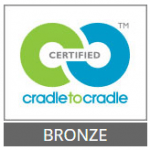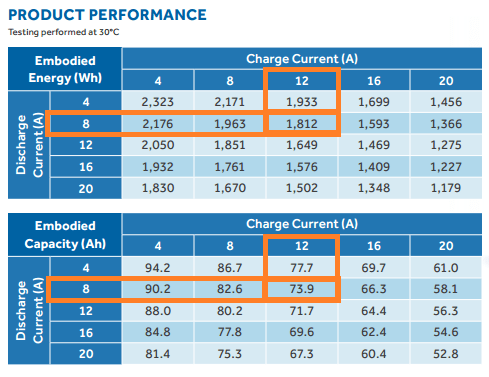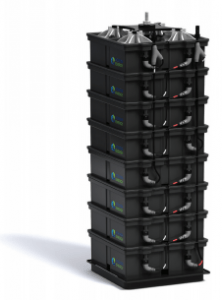New kid in town
Aquion Energy has recently released a new member of their saltwater deep cycle battery family. It is the Aspen 24S-83, a 24V 83 amp hour (Ah) battery for smaller 24 volt (V) DC solar systems. The Aspen 24S-83 looks very similar to its big brother, the 48V Aspen 48S-2.2. It is just wired differently to achieve the lower voltage. Both the 48V battery and the 24V battery have about the same watt hours (Wh),depending on the charge and discharge rate. More on that later. But the 24V version is wired with two parallel strings of four 6V cells, and the 48V version is one string of eight 6V cells.
What’s so cool about Aquion Energy Batteries?

Certified Environmentally friendly
Aquion Energy Aspen batteries are 100% non-toxic, non-flammable, and non-hazardous. Their abundantly available ingredients are carbon, salt water, synthetic cotton, and manganese oxide. They are certified Cradle-to-Cradle Bronze, meaning they are environmentally friendly. Aquion batteries are also able to be more deeply discharged than typical deep cycle batteries, allowing you to use more of the energy stored in the battery bank. This lets you use a smaller battery bank than with lead acid batteries. The Aquion batteries will also last longer than a lead acid battery, saving you money over the life of your solar power system.
How much energy does it hold?
The Aspen battery’s capacity varies significantly based on how fast you put power in and pull power out of the battery bank. The maximum rate for continuous current in or out of the battery is 30 amps(A). However, for better capacity, it is recommended you don’t design it for more than 20A. To determine how many watt hours (Wh) or amp hours (Ah) the battery has, you must find the junction of how much current you are putting in while charging and pulling out, powering your load.

Aquion Energy 24S-83 capacity
For example, if you have 300 watts (W) of solar, and you are charging the 24V battery, 300W / 24V = 12.5A. You look down the 12A Charge column. Now if you have a 200W load you are powering, 200W / 24V = 8.3A. So you look across the 8A Discharge row. The top table tells you the battery can hold 1,812Wh. The bottom table tells you the battery has 73.9Ah of storage capacity. If you have higher wattage needs, you simply increase the number of batteries in parallel, and divide the current across the battery bank.
Why 24V?
We are seeing a lot of people replacing their old, lead acid battery banks with the new, green, and long lasting Aquion batteries. However, a lot of people had 24V systems, and the Aquion 48V battery wasn’t a good option for them. To switch to 48V they would need to replace their inverter, and possibly re-wire or add to their solar array. The new Aquion 24S-83 allows an easy drop in replacement to your existing 24V system.
If you are designing a new solar system, the restriction of limiting your parallel strings of batteries is now gone. Since Aquion batteries can operate in a partial state of charge (PSoC) there is no risk of damaging your battery bank with uneven charging and discharging. Unlike most deep cycle batteries, the Aquion battery bank can consist of as many batteries in parallel that are needed to handle the load.If there is an imbalance, they will self equalize. This allows you to grow your existing system as your needs grow.


Let’s say I have 4 stacks. And I drain them down all the way. If I had only a generator to recharge. What size generator just to recharge the stacks only. Say in watts. Then what size charger do you use to recharge 4 stacks as quick as possible. How many amp charger? Or break this down to me in lay mans terms. At this time I don’t need the solar panel end of it. Thanks Kevin
I Want Mine! Thinking of getting 9 stacks for my 4000sq.ft. home, but I’m trying to figure out how to configure my existing 9kw enphase micro inverter grid-tie system to use a battery backed inverter. My 1st consideration was the Aims 6kw 240v split phase, but then all my solar panels go dark in a grid down situation! HELP.
I assume you are talking about doing an AC coupled system, where the output of the off-grid inverter is connected to the output of the grid tie inverters. We’ve done several videos on that. We’ve designed systems with Outback, Schneider, Magnum, and SMA. You need to make sure there is a method for turning off the grid tie inverter when the batteries are full. However, I’m not quite sure if an Aims inverter will support that, and we don’t have any experience with them. I recommend you take a look at how Midnite Solar does AC coupling with the Magnum inverter for an example. https://www.altestore.com/static/datafiles/Others/d3raccplme_AC_Coupled_manual.pdf
Thank you for your reply! I’ve saved this pdf and will discuss with my solar electrician.
You’re only missing two data points – Price and capacity in watt-hours at nominal voltage.
Oops, our links to the product weren’t working. Thanks for pointing that out. You can find up to date pricing at https://www.altestore.com/store/deep-cycle-batteries/saltwater-batteries/aquion-energy-saltwater-batteries-p40483/#AQU24S-83 . It is currently $1195 for each stack, the same as the 48V version.
The watt hours is covered in the article. It varies based on the charge and discharge rate, so we discuss how to determine how much energy it holds. Simply saying it has 2.1kWh without stating the rates doesn’t give the full story.
Thank you for creating the batteries !